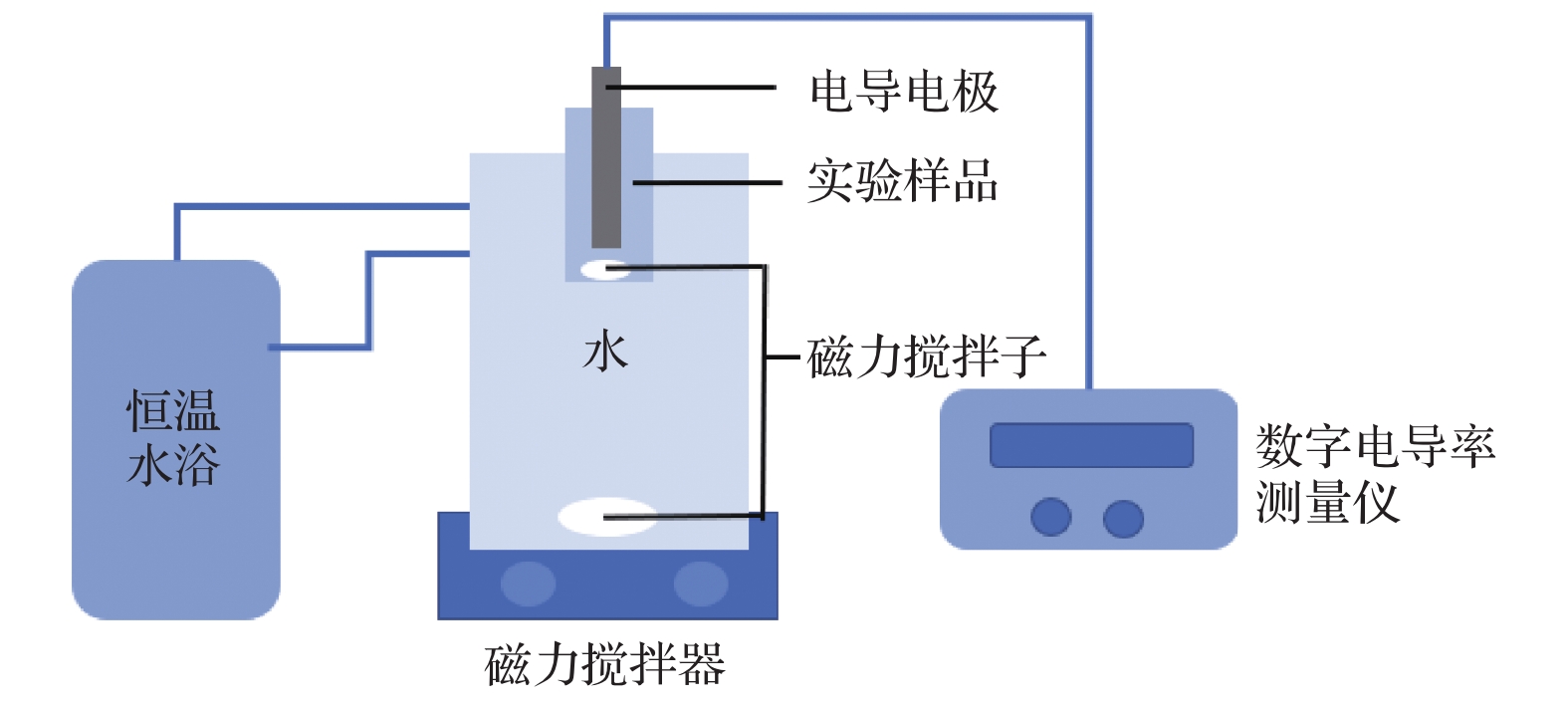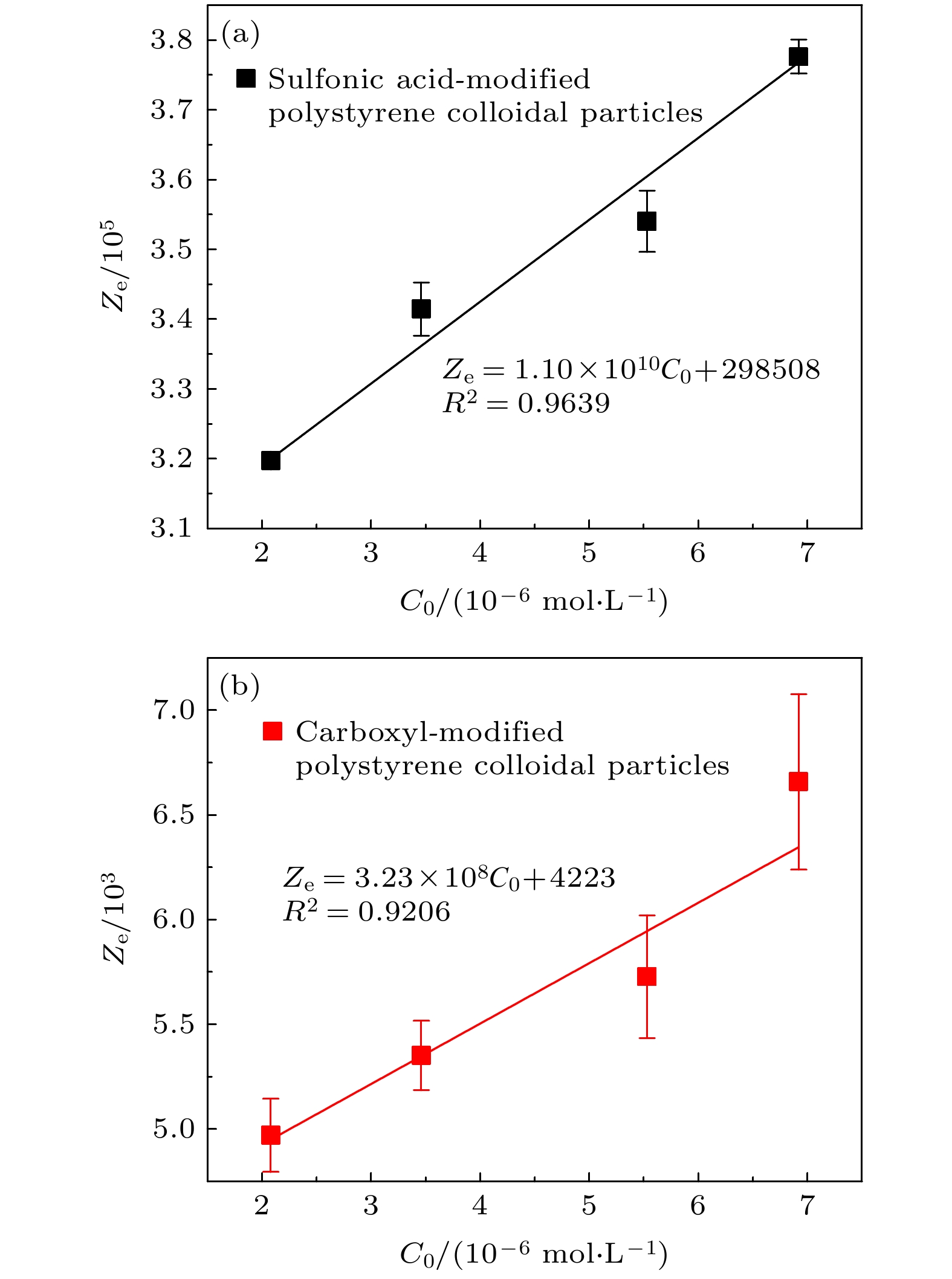-
胶体粒子的表面有效电荷是决定胶体性质的重要物理量, 但溶液环境(如电解质溶液浓度)是否影响其数值至今尚无统一认识, 近年来的一些研究工作给出了存在争议的不同结果和假设. 在直接实验测量方面, 由于电解质离子和胶体表面吸附离子的置换, 粒子表面基团的不完全电离和胶体粒子对离子吸附的共同作用, 使得对这类粒子在不同溶液环境下的表面有效电荷的测量和变化机理的认识极为困难. 针对该问题, 本文测定了羧基和磺酸基修饰的聚苯乙烯胶体颗粒在不同粒子浓度和HCl浓度下的电导率, 由于两种粒子与HCl电离产生的阳离子相同(均为H+), 可根据电导率-数密度法(迁移法)得到胶体颗粒表面有效电荷数. 通过实验结果分析, 明确了HCl浓度以及粒子数密度对胶体粒子表面电荷的影响规律以及表面电荷随HCl浓度增大的原因. 除此之外, 羧基修饰颗粒比磺酸基修饰颗粒的表面电荷随HCl浓度变化更快; 对于同一HCl浓度, 磺酸基修饰胶体表面电荷不受粒子数密度影响, 而羧基修饰胶体颗粒却与之相关. 基于粒子表面电荷的理论模型, 对这些问题都给出了相应的解释.The effective surface charge of colloid particles is an important parameter that determines the colloidal properties. However, it is still unclear whether the solvent environment (such as the electrolyte concentration) can affect the effective surface charge. Due to complicated effects relevant to the effective surface charge, such as the exchange of dissociable ions between the electrolyte and surface groups of polystyrene particles, the coupling effect of incomplete ionization of the surface groups of the particles and the adsorption of ions by colloidal particles, etc., it is rather difficult to accurately measure the surface charge and understand the mechanism of charge variation with solvent environment. To solve this problem, we measure the conductivities of polystyrene colloidal particles of carboxyl groups and sulfonic acid groups at various particle number densities and HCl concentrations. Since the cations generated from the two kinds of particles and HCl solution are all H+ cations, the surface charge can be obtained by the conductivity-number density method (migrant method), no matter whether the cation exchanges occur between ionized positive ions of the electrolyte and colloidal particles. Based on the experimental results, the influences of HCl concentration and particle number density on the surface charge of colloidal particles are detected, and the reasons of the influence are analyzed. It is found that the change of the surface charge of the particles of carboxyl group with HCl concentration is faster than that of sulfonic acid group with the HCl concentration. For the same electrolyte concentration, the effective surface charge of carboxyl modified colloidal particles is related to the particle number density, while the charge of sulfonic modified particles is not. Considering the fact that the sulfonic acid group and carboxyl group are strong and weak acid groups respectively, the ionization of H+ cations of the two different groups have profound influences on the cation replacement process, and affect the trend of the curve of the conductivity-particle number density. This effect further results in different change tendencies of effective surface charge with HCl concentration and particle number density. According to the theoretical model as described in this study, all experimental results are well explained. The mechanisms described in this article will be useful for stating the influencing factors of the surface effective charge, and the application of the effective charge to different phenomena relating to interparticle interactions with different parameters of solutions.
-
Keywords:
- colloidal particles /
- effective surface charge /
- electrolyte concentration /
- particle number density
[1] Alexander S, Chaikin P M, Grant P, Morales G J, Pincus P, Hone D 1984 J. Chem. Phys. 80 5776
 Google Scholar
Google Scholar
[2] Grosse C, Shilov V N 2000 J. Colloid Interf. Sci. 225 340
 Google Scholar
Google Scholar
[3] Yi G R, Pine D J, Sacanna S 2013 J. Phys. Condens. Matter 25 193101
 Google Scholar
Google Scholar
[4] Frenkel D 2006 Science 314 768
 Google Scholar
Google Scholar
[5] Derjaguin B V 1992 Russ. Chem. Bull. 31 557
[6] Derjaguin B V, Landau L D 1993 Prog. Surf. Sci. 43 30
 Google Scholar
Google Scholar
[7] Manuela V, Ingo K, Arno K 2013 Advances in Nanoparticles 2 287
 Google Scholar
Google Scholar
[8] Auer S, Frenkel D 2002 J. Phys. Condes. Matter 4 3053
[9] Gu L Y, Xu S H, Sun Z W, Wang J T 2010 J. Colloid Interface Sci. 350 409
 Google Scholar
Google Scholar
[10] Jiménez-Ángeles F, M Lozada-Cassou 2008 J. Chem. Phys. 153 069901
[11] Wette P, Schöpe H J, Palberg T 2002 J. Chem. Phys. 116 10981
 Google Scholar
Google Scholar
[12] Yamanaka J, Hayashi Y, Ise N, Yamaguchi T 1997 Phys. Rev. E 55 3028
[13] Yamanaka J, Matsuoka H, Kitano H, Ise N 1990 J. Colloid Interface Sci. 134 92
 Google Scholar
Google Scholar
[14] Gong Y K, Nakashima K, Xu R 2001 Langmuir 17 2889
 Google Scholar
Google Scholar
[15] Hessinger D, Evers M, Palberg T 2000 Phys. Rev. E. 61 5493
 Google Scholar
Google Scholar
[16] 王林伟, 徐升华, 周宏伟, 孙祉伟, 欧阳文泽, 徐丰 2017 66 066102
 Google Scholar
Google Scholar
Wang L W, Xu S H, Zhou H W, Sun Z W, OuYang W Z, Xu F 2017 Acta Phys. Sin. 66 066102
 Google Scholar
Google Scholar
[17] Heinen M, Palberg T, Löwen H 2014 J. Chem. Phys. 140 124904
 Google Scholar
Google Scholar
[18] Gutsche C, Keyser U F, Kegler K, Kremer F 2007 Phys. Rev. E 76 031403
[19] Davis J A, James R O, Leckie J O 1978 J. Colloid Interface Sci. 83 1401
[20] Barr S A, Panagiotopoulos A Z 2011 Langmuir 27 8761
 Google Scholar
Google Scholar
[21] Sumaru K, Yoshida H, Koga T, Ise N, Hashimoto T 1998 Phys. Rev. Lett. 80 5806
 Google Scholar
Google Scholar
[22] Delgado A, González-Caballero F, Hunter R J, Koopal L K, Lyklema J 2007 J. Colloid Interface Sci. 309 194
 Google Scholar
Google Scholar
[23] Zhou H W, Xu S H, Sun Z W, Du X, Liu L X 2011 Langmuir 27 7439
 Google Scholar
Google Scholar
[24] Sven H B, David G G 2001 J. Chem. Phys. 115 21218
[25] Malek O K, Simon P, Derek Y, Chan C 2005 J. Chem. Phys. 122 2221
[26] Guerrero-García G I, González-Tovar E, Lozada-Cassou M, de J Guevara-Rodríguez F 2005 J. Chem. Phys. 123 034703
 Google Scholar
Google Scholar
[27] Banchio A J, Nagele G 2008 J. Chem. Phys. 128 349
[28] Gouy G 1910 J. Phys. 9 457
[29] 朱华玲, 李兵, 熊海灵 2009 物理化学学报 25 1004
 Google Scholar
Google Scholar
Zhu H L, Li B, Xiong H L 2009 Acta Phys.Chim. Sin. 25 1004
 Google Scholar
Google Scholar
-
图 6 磺酸基(a), 羧基(b)修饰聚苯乙烯胶体颗粒关于单个粒子引起的电导率变化量(σ–σ0)/n与单个粒子对应的电解质离子浓度NAC0/n关系曲线
Fig. 6. Conductivity contribution per particle (σ–σ0)/n as a function of the number concentration of small ions per particle NAC0/n performed on sulfonic acid-modified (a) and carboxyl-modified (b) polystyrene colloidal particles.
表 1 实验中所使用的粒子参数
Table 1. Parameters of the particles.
Sample Surface groups Diameter/nm Polydispersity Mobility/(10–8 m2·V–1·s–1) PS-1 Carboxyl (—COOH) 300 < 0.03 2.8 PS-2 Sulfonic acid (—SO3H) 300 < 0.03 6.7 表 2 磺酸基修饰聚苯乙烯胶体颗粒的σ-n曲线斜率以及表面有效电荷数
Table 2. The slope of σ-n curve and the surface effective charge of sulfonic acid-modified polystyrene.
C0/(10–6 mol·L–1) Slope/(10–20 S·m2) Ze 2.08 2.21 319734 3.46 2.36 341435 5.53 2.47 354022 6.92 2.61 377604 表 3 羧基修饰聚苯乙烯胶体颗粒表面有效电荷数
Table 3. The surface effective charge of carboxyl-modified polystyrene.
C0/(10–6 mol·L–1) Ze 2.08 4970 3.46 5351 5.53 5728 6.92 6658 表 4 磺酸基修饰聚苯乙烯颗粒的有效电荷
$ {Z}_{\mathrm{e}}^{*} $ Table 4. The surface effective charge
$ {Z}_{\mathrm{e}}^{*} $ of sulfonic acid-modified polystyrene.C0/
(10–6 mol·L–1)Slope/
(10–26 S·m2)Intercept/
(10–20 S·m2)$ {Z}_{\mathrm{e}}^{*} $ 2.08 6.94 2.16 312297 3.46 6.93 2.31 333420 5.53 6.91 2.50 362225 6.92 6.92 2.64 382204 表 5 羧基修饰聚苯乙烯颗粒的有效电荷
$ {Z}_{\mathrm{e}}^{*} $ Table 5. The surface effective charge of
$ {Z}_{\mathrm{e}}^{*} $ carboxyl-modified polystyrene.C0/
(10–6 mol·L–1)Slope/
(10–26 S·m2)Intercept/
(10–22 S·m2)$ {Z}_{\mathrm{e}}^{*} $ 2.08 6.50 3.12 5199 3.46 6.67 3.62 5766 5.53 6.73 3.90 6208 6.92 6.82 4.75 7397 -
[1] Alexander S, Chaikin P M, Grant P, Morales G J, Pincus P, Hone D 1984 J. Chem. Phys. 80 5776
 Google Scholar
Google Scholar
[2] Grosse C, Shilov V N 2000 J. Colloid Interf. Sci. 225 340
 Google Scholar
Google Scholar
[3] Yi G R, Pine D J, Sacanna S 2013 J. Phys. Condens. Matter 25 193101
 Google Scholar
Google Scholar
[4] Frenkel D 2006 Science 314 768
 Google Scholar
Google Scholar
[5] Derjaguin B V 1992 Russ. Chem. Bull. 31 557
[6] Derjaguin B V, Landau L D 1993 Prog. Surf. Sci. 43 30
 Google Scholar
Google Scholar
[7] Manuela V, Ingo K, Arno K 2013 Advances in Nanoparticles 2 287
 Google Scholar
Google Scholar
[8] Auer S, Frenkel D 2002 J. Phys. Condes. Matter 4 3053
[9] Gu L Y, Xu S H, Sun Z W, Wang J T 2010 J. Colloid Interface Sci. 350 409
 Google Scholar
Google Scholar
[10] Jiménez-Ángeles F, M Lozada-Cassou 2008 J. Chem. Phys. 153 069901
[11] Wette P, Schöpe H J, Palberg T 2002 J. Chem. Phys. 116 10981
 Google Scholar
Google Scholar
[12] Yamanaka J, Hayashi Y, Ise N, Yamaguchi T 1997 Phys. Rev. E 55 3028
[13] Yamanaka J, Matsuoka H, Kitano H, Ise N 1990 J. Colloid Interface Sci. 134 92
 Google Scholar
Google Scholar
[14] Gong Y K, Nakashima K, Xu R 2001 Langmuir 17 2889
 Google Scholar
Google Scholar
[15] Hessinger D, Evers M, Palberg T 2000 Phys. Rev. E. 61 5493
 Google Scholar
Google Scholar
[16] 王林伟, 徐升华, 周宏伟, 孙祉伟, 欧阳文泽, 徐丰 2017 66 066102
 Google Scholar
Google Scholar
Wang L W, Xu S H, Zhou H W, Sun Z W, OuYang W Z, Xu F 2017 Acta Phys. Sin. 66 066102
 Google Scholar
Google Scholar
[17] Heinen M, Palberg T, Löwen H 2014 J. Chem. Phys. 140 124904
 Google Scholar
Google Scholar
[18] Gutsche C, Keyser U F, Kegler K, Kremer F 2007 Phys. Rev. E 76 031403
[19] Davis J A, James R O, Leckie J O 1978 J. Colloid Interface Sci. 83 1401
[20] Barr S A, Panagiotopoulos A Z 2011 Langmuir 27 8761
 Google Scholar
Google Scholar
[21] Sumaru K, Yoshida H, Koga T, Ise N, Hashimoto T 1998 Phys. Rev. Lett. 80 5806
 Google Scholar
Google Scholar
[22] Delgado A, González-Caballero F, Hunter R J, Koopal L K, Lyklema J 2007 J. Colloid Interface Sci. 309 194
 Google Scholar
Google Scholar
[23] Zhou H W, Xu S H, Sun Z W, Du X, Liu L X 2011 Langmuir 27 7439
 Google Scholar
Google Scholar
[24] Sven H B, David G G 2001 J. Chem. Phys. 115 21218
[25] Malek O K, Simon P, Derek Y, Chan C 2005 J. Chem. Phys. 122 2221
[26] Guerrero-García G I, González-Tovar E, Lozada-Cassou M, de J Guevara-Rodríguez F 2005 J. Chem. Phys. 123 034703
 Google Scholar
Google Scholar
[27] Banchio A J, Nagele G 2008 J. Chem. Phys. 128 349
[28] Gouy G 1910 J. Phys. 9 457
[29] 朱华玲, 李兵, 熊海灵 2009 物理化学学报 25 1004
 Google Scholar
Google Scholar
Zhu H L, Li B, Xiong H L 2009 Acta Phys.Chim. Sin. 25 1004
 Google Scholar
Google Scholar
计量
- 文章访问数: 9991
- PDF下载量: 111
- 被引次数: 0














 下载:
下载:









